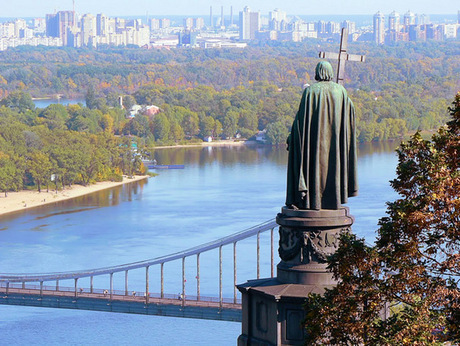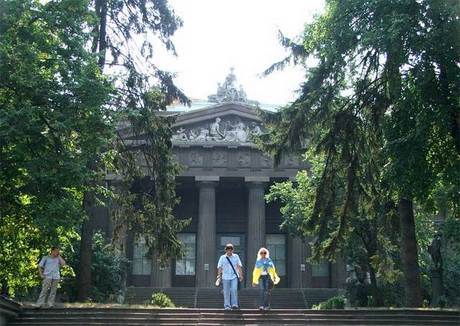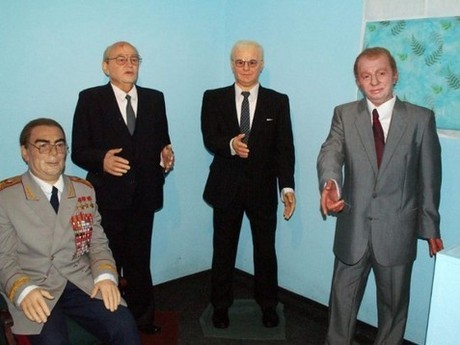Ukraine
Ukraine

Vladimirskaya Gorka is a visit card of Kiev. It is a green and cozy place with old pavilions offering picturesque views on the left bank of Dnepr and the river itself. On Vladimirskaya Gorka young people come to celebrate graduation from school and enjoy the first sunrise of their new life. It is also the place where just married couples arrive to take beautiful pictures and enjoy the picturesque landscapes.

One hundred years ago, at the beginning of the history of the National Art Museum of Ukraine, which was first called the City Museum of Antiques and Art, there was hardly any concept of Ukrainian professional art. Ukraine was always famous for its national ethnographical applied art. The founders of the museum's collections decided to prove that this opinion was wrong and defined the list of main representatives of Ukrainian fine art. These scientists have included in the list not only those who were born and worked in Ukraine, but also those national-conscious artists who lived abroad. They thought that foreigners who worked in Ukraine have enriched a national culture too. These principles were the basis of their collective work.

From the ancient times the wax was used for various purposes - for mummy preservation or as a protectant for oil paintings and frescoes. Romans made wax moulds of dead people's faces. The portraits of friends and relatives were also made of wax. In the Middle Ages the wax sculptures were often located in Roman and Gothic churches and chapels.

The Museum of Art named after Bogdan and Varvara Khanenko was founded in 1919 on the basis of their private museum. The museum is also called the Museum of Western and Oriental Art. Now it keeps one of the best collections of foreign art in Ukraine. From 1919 the number of exhibits has been more than 13 times increased - from 1,250 to nearly 17,000 artworks, with 2,000 pieces exposed in museum halls. Visitors can view many remarkable samples of foreign art: Ancient Greek, Roman, Italian, French, Spanish, Flemish, Dutch, Japanese, Chinese, Persian, Turkish, Egyptian, etc.

In 1863 the Branch of the Emperor Russian Musical Society was established in Kiev. This year is an important milestone in the history of musical life of Ukraine and Kiev. It had been rapidly developing since the first part of the 19th century.

In Kiev, there are several botanical gardens: the one named after academic Fomin, the State Botanical Garden, and the Botanical Garden of the Ukrainian Academy of Science. The last one is probably the most picturesque garden in Kiev: the garden not only contains various kinds of plants, but also neighbors with the beautiful Vidubitsky monastery.

Kiev Zoo was founded in 1908 by the Nature Lovers Society and financed by private donations. At the beginning the zoo experienced difficult times and could not boast a great amount of animals: there were just 17 kinds. The first winter the animals had to spend in the food department of the main Kiev railway, as the zoo founders did not find a shelter for the animals they possessed.

Trukhanov Island is an island located on the Dnieper River opposite the historic Podil neighbourhood of the city of Kiev. It has an area of 4.5 km2 (1.7 sq mi). The island is mostly covered by greenery, like the Hidropark island nearby. Until 1957, the only method of transportation to the island was by boat in the summer or by crossing the ice in the winter. In 1957, the Park Pedestrian Bridge was built, easing the travel to and from the island.

Park Slavi, or the Park of Glory, is located on the intersection of Sichnevogo Povstaniya Street, Suvorova Street and Dmitrievsky Slope. The park is dedicated to the memory of those heroes who died defending Kiev and Ukrainian lands.

The National Academic Theatre of Opera and Ballet named after T.G. Shevchenko is the oldest musical theatre in Ukraine. It was founded in 1867. Its first season was opened with the opera Askold's Grave by A. Verstovsky. While at that time Ukraine was a part of Russian Empire, mainly the operas of Russian composers were staged, such as Mermaid by A. Dargomyzhsky, Life for Tsar and Ruslan and Lyudmila by М. Glinka, Queen of Spades and Mazepa by P. Tchaikovsky.
 1 23 4 5 6 7 8 9 10 11 12 13 14
1 23 4 5 6 7 8 9 10 11 12 13 14 
